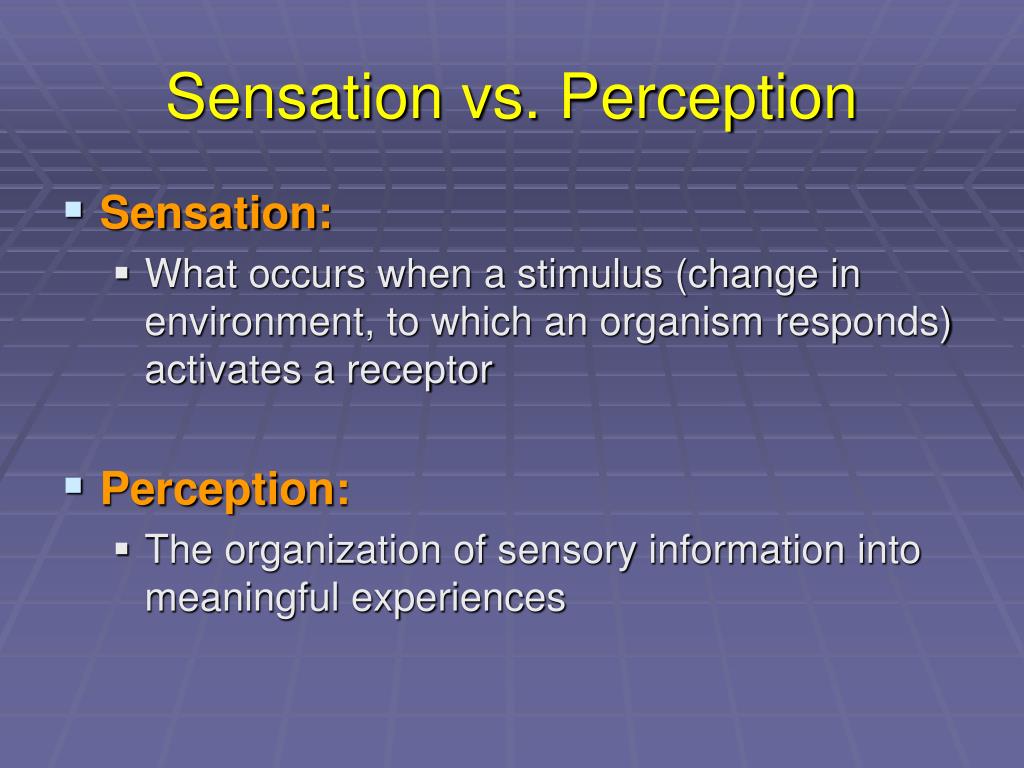
It is also possible for us to get messages that are presented below the threshold for conscious awareness-these are called subliminal messages. Under quiet conditions, the hair cells (the receptor cells of the inner ear) can detect the tick of a clock 20 feet away (Galanter, 1962). It has been estimated that on a clear night, the most sensitive sensory cells in the back of the eye can detect a candle flame 30 miles away (Okawa & Sampath, 2007). The sensitivity of our sensory receptors can be quite amazing. Another way to think about this is by asking how dim can a light be or how soft can a sound be and still be detected half of the time. Absolute threshold refers to the minimum amount of stimulus energy that must be present for the stimulus to be detected 50% of the time. The sensitivity of a given sensory system to the relevant stimuli can be expressed as an absolute threshold. We also have sensory systems that provide information about balance (the vestibular sense), body position and movement (proprioception and kinesthesia), pain (nociception), and temperature (thermoception). It turns out that this notion of five senses is oversimplified.

You have probably known since elementary school that we have five senses: vision, hearing (audition), smell (olfaction), taste (gustation), and touch (somatosensation). The conversion from sensory stimulus energy to action potential is known as transduction. These cells relay messages, in the form of action potentials (as you learned when studying biopsychology), to the central nervous system. For example, light that enters the eye causes chemical changes in cells that line the back of the eye. When sensory information is detected by a sensory receptor, sensation has occurred. The brightness constancy keeps the brightness property of an object constant irrespective of how light or dark the surrounding is.What does it mean to sense something? Sensory receptors are specialized neurons that respond to specific types of stimuli. Similarly, shape constancy ensures the fact that the shape of an object does not change even if the viewpoint of the object stands different and multiple. The fact that different viewpoint does not change the size of the object is the principle of a perceptual process known as size constancy. These different viewpoints of the object do not change the size of the object or the image. When we view an object, the angles of the view could be multiple. These perceptual constancies are size constancy, shape constancy, and brightness constancy. These constancies do not change irrespective of how the stimuli of the object being viewed are taken in. Certain elements of perceptual processes are constant. Perception is that natural filter attached in our brain that allows us to meaningfully interpret the world which helps us to exist without being overwhelmed by an abundance of information and stimuli. When the sensory organs send external stimuli to the brain and transduction takes place, where the external stimuli are converted into neural signals and in turn, these neural signals are taken out in the form of perception. Perception is the method by which the brain takes in all the information from the environment through the sensory organs or the senses and takes out the information allowing the individual to form a systematic and meaningful interpretation of the same.
#Sensation vs perception definition skin#
In a similar manner, olfaction is the sense of smell that takes place through the receptors in the nose and creates neural signals which go to the olfactory bulbs in the brain.Somesthetic sense includes the senses that place in the skin also known as kinesthetic sense. Gustation is the sense of taste which takes place in the taste buds located in the tongue. Auditory perception takes place when sounds in the form of vibrations travel through the ears, sends signals to the brain, and perception of sound takes place. The eyes then send the vision of the object in the form of signals of light to the brain and the brain as a result creates the picture in the mind. In order to see any object, the light must get reflected from this object source and travel through the retina of the eyes. But when the external stimuli are unchanging from a long period of time, sensory adaptation takes place in the form of habituation. This process of converting external stimuli into a neural signal is called transduction.

The sensory receptors allow these stimuli to become neural signal after getting into the brain.

Sensation takes place when the special receptors located in the sensory organs – eyes, ears, nose, tongue, and skin are activated.


 0 kommentar(er)
0 kommentar(er)
